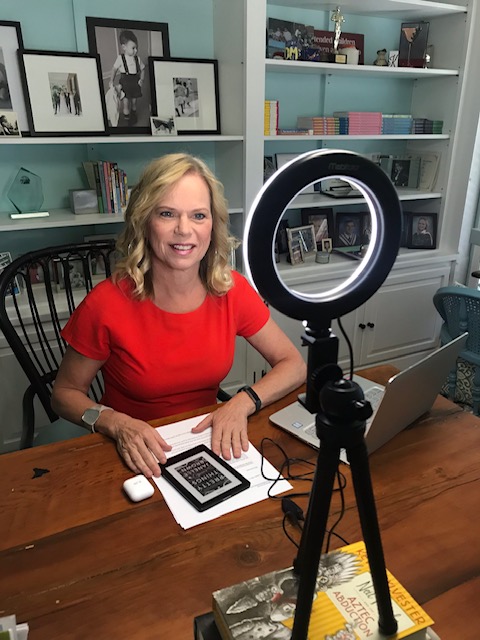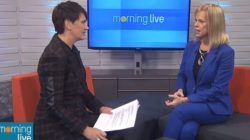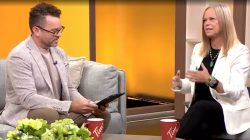For some of us used to doing in-studio television segments, the switch to Zoom or Skype interviews which are still aired on national or local channels has been a bit of learning curve. We’ve had to become responsible for our own video quality, lighting, audio, connectivity and set decoration. It had become rare to get make up professionally done at a studio, and even more rare to have someone help you with your hair, but that’s an extra challenge to face when airing from home, as well.
I’ve done hundreds of in-studio interviews over the past 15 years, and I still consider myself a bit of a newbie after doing about 20 so far from my home office. I’ve even helped my two daughters with segments in my kitchen for national television. I’ve gathered tips and techniques from other professionals, as well as the studios themselves, and I’ll share them here, should you find yourself being asked to provide your insight on a television show, IGTA, or FB Live event.
- At least 24 hours before:
- Lighting is extremely important. If your budget allows, consider investing in a ring light. Most will also include a tripod feature for your phone to be held, keeping your camera steady. Check the lighting at the same time of day when you’ll be doing the interview. Avoid daylight (windows) and bright lights behind you.
- Check your audio by connecting with a friend prior to doing the interview. iPhone Air Pods are an expensive but high quality option, as is the purchase of a plug-in microphone.
- The difference between your laptop and your phone can be significant. Try both, again over the medium you will be using for the interview, with a friend and choose the one that has the best clarity.
- Make sure you are in a room that has good access to WIFI and or your data. If using Wi-Fi___33 make sure your device will automatically revert to data should your connection be interrupted.
- Media for interview. Are you Skyping? Zooming? On FB Live? Try the one out that you are using, even if you have used it in the past. You don’t want to be dealing with a software updates five minutes before you’re supposed to be on air.
- Set Decoration. What’s behind you? What’s in front of you? Can you design your own background? If you’re not sure, the best thing to do is to find a blank wall and take down any pictures that might be distracting. Try not to display all of your awards.
- Make up/hair/clothing. Do a trial run. If you haven’t done television make up before, consider watching some YouTube videos. It will seem like a lot of make up compared to your daily wear. Hair can melt under hot lights (if you invested in that ring light) so make sure you have some hairspray and extra product on hand. What are you wearing? Not all colours are great on camera. Stark black and white patterns are not good. Take a look at what you’re wearing through the camera’s lens, not just your bedroom mirror lens. And make sure if you’re thinking that you can just get away with a nice blouse or top, that in fact, no one can see what you’re wearing on the bottom.
- Position yourself. Your head should be central in the screen, with a bit of space above it, but not too much. Make sure your camera, be it on laptop or phone is at eye level. This is the best tip I can give you. Do not be looking down at your laptop. Prop it up on books, etc.
- B-roll or photos. Make sure you have sent your B-roll video footage or photos in to the producer in advance. They may not be high enough quality to use, and if they are central to your interview, you’ll have to make some adjustments.
- Social media notifications. Send out notices of your appearances on Twitter, Facebook, Instagram, etc., if you want people to tune in live.
- Confirm interview time. Make sure you know when you are connecting versus when you will be live on air. Some studios will call you two minutes before, some like you on the line 20 minutes prior, or might want to run a test the day before.
- If the studio sends you interview tips and information, read it!
- Hour before:
- Test call. Test call a friend over the medium you’ll be using, to make sure nothing is disconnected or off line. If the studio can’t connect with you, your interview will be dumped. They rarely reschedule.
- Notify the real-life folks you’re going live. Tell the people in your house that you are doing this call and make sure you have a room with a closed door, if possible. Put a sign outside asking people not to ring the doorbell. I’ve discovered “Baby Sleeping” works well.
- Notifications online. Turn off all notifications for social media, messaging, phone calls, etc. from your phone so they don’t pop up either on screen for everyone to see, or even you. It’s distracting.
- Volume on. Make sure the volume is turned on your phone or laptop.
- Check news outlet online. Prior to the call, if they livestream, watch the show and see how they are previewing you, as well as learning the names of the hosts and the tone of the show.
- Make sure everything is charged. Ring light might need to be plugged into your laptop, Air Pods need charging, etc.
- Make sure shot is easy to adjust. Studio might ask you to move it up, down, left, right, forwards, backwards. If you have a perilous set up (i.e. tripod on top of books) might be difficult to do quickly.
- While on air:
- Turn off your laptop if it is distracting to you. The volume on devices you are not using for the interview should be turned off. Still have a landline? Unplug that too.
- Eyes on camera. Don’t look down. If you have notes you need to look at, post them at eye level, like cue cards.
- For many interviews, you won’t see the person interviewing you at all. You’ll possibly see yourself, and then a black background beside you. This is another reason why having excellent audio is important. You need to listen for cues to answer, without visual ones.
- Try not to move around too much, or knock the table or desk your camera is on. Talking with your hands could result in knocking something askew.
- If a child or clueless adult wanders in during your interview, just go with it. Getting too upset or uptight will guarantee more coverage than you want.
If you are planning on an outside segment, make sure you follow all of the tips above, but also prepare for the unexpected; weather, noises from the street, neighbors, animals, etc. No sunlight at your back.
If you are showing products, make sure you test your table set up for the camera as well. If your camera is set up with a tripod, you won’t be able to zoom in on items, and the station may want that. Either employ someone in your house with a steady hand to film you (and practice before), or provide the station with pre-recorded videos they can slot in.
Above all, do some practice runs with all of the above. You’ll be able to pick out all of the technical challenges, but also rehearse what you want to say. Most segments are between three to five minutes long. Have someone act as the interviewer. This is easier to do if you have watched the show you will be on, and you can get to know their style of interviewing.
Hot tip: “Live” segments are always delayed on air by a minute or so. When your segment ends, grab your camera and grab some screen shots off your laptop or tv. You should be on there for another minute or so. This is helpful if the station decides not to post your video online, if you want to prove that it did really happen.
After your segment airs, you should be able to find it on the station’s “video” section. Worth promoting on Linked In, Twitter, Facebook and Instagram. If you have a site, post it there.
Good luck!








1 Comment
Such great tips, Kathy! I’ll be sure to put them to work.